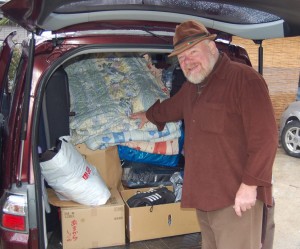
Charles Begley before van stocked with food and goods for friends in Sendai
On March 26, Charles Begley and I drove to the city of Sendai to bring supplies to a small Christian community of 6 adults and 7 children. It was a 4 hour drive along the Banetsu and Tohoku expressways and was through Fukushima prefecture. As you see from the map, the Tohoku expressway is about 58 kilometers or 36 miles from the two troubled nuclear power-plants in Fukushima.
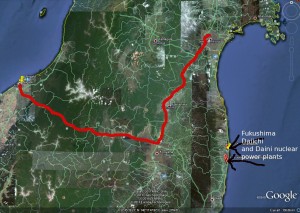
Route from Niigata to Sendai
Charles’ van was completely filled with supplies, thanks to friends in Niigata and a donation of money from the director of NPO Leap High 28, Yoko Ishikawa, with whom I am working with in building the Help Japan 2011 web site. In all we took approximately 80,000 yen or about $1000 US worth of food and goods. This included 105 kg of rice, bags of white radish (daikon), potatoes, carrots, eggplant, onions, noodles, curry and stew ingredients, can goods, 24 packs of nattou, 2 camping stoves, 35 cans of can fuel for the stoves, 90 liters of kerosene for heating, clothes, blankets, and shoes. Most of these items are now hard to find or buy in Sendai, a city of one million people, the largest city of northeast Japan and the closest to the epicenter of the earthquake on March 11th in the Pacific. Some materials like clothes, shoes and blankets were not immediate needs of my friends in Sendai, but items they would distribute to others in need.
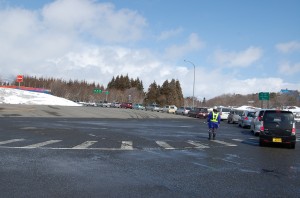
Cars lined up to get gas at the Bandaisan service area on the Banetsu expressway in Fukushima
The Tayama family was very grateful for the food and the means to cook it. They had no vegetables the past two weeks. Until a few days ago, they had no electricity. They still have no running water or gas.
Visual impressions
Much unlike my visit to the city of Ojiya in Niigata after the October 2004 earthquake when I saw destruction in any direction I looked, I saw no destruction or damage of anything whatsoever. The roads were not broken as they were in Niigata, and no houses fell. The only sign that something had happened was many convenience stores where closed. That is not to say there was no direct destruction at all from the earthquake. One friend reports his apartment was damaged to the point of becoming unlivable which forced him to move. But the overall direct damage from the earthquake seemed to be minimal. The real destruction was caused by the tsunami along perhaps 500 kilometers of the Pacific coast, up to 10 kilometers inland. This is roughly 5000 square kilometers of devastation!
It was cold and snowy in the mountains of Fukushima, but there was no snow in Sendai and not too cold in my friend’s house even without the heaters on. But it was still daytime with a clear sky. The sun helps warm the houses. The Pacific side of Japan has a much higher percentage of sunny days than the west coast along the Sea of Japan. I’m sure it does get colder at night, and all that donated kerosene will be used for heating.
We came to a point in Sendai about 14 kilometers or 8 miles from the Pacific coast. My friend Charles did not want to purposely drive close enough to see any destruction. He said he saw enough of it on TV.
Photos after arriving in Sendai
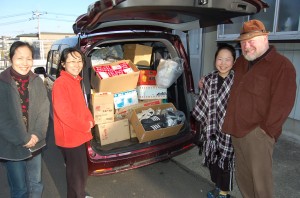
Happy recipients of goods
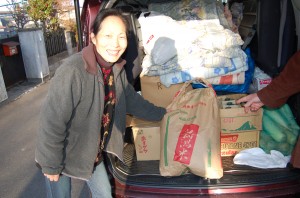
Mrs. Tayama with one of the three 30 kilograms of rice donated by friends in Niigata

Charles with the Tayamas
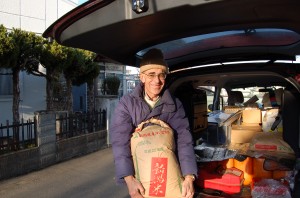
Yours truly struggling to hold the 30 kilogram bag of rice waiting for Charles to figure out how to use the camera.
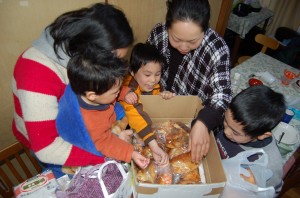
The children rejoicing over the box of bread products donated by a bakery in Niigata
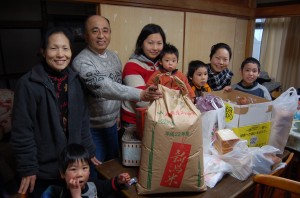
The Tayama family with some of the supplies they received.
Testimonials from Friends in Sendai
Mrs. Tayama: “I work as a maid in a large hotel in Sendai. I was on the 10th floor in standing in front of the elevator when the earthquake hit. As soon as I pushed the down button to call the elevator, the building started to shake. It shook so bad I couldn’t stand up without falling. I crouched down on the floor and stayed there till the shaking stopped.”
Mr. Tayama: “The night of the earthquake we all slept with our clothes on. Tremors continued through the night. We knew we all may have to evacuate the building at any time. ”



























